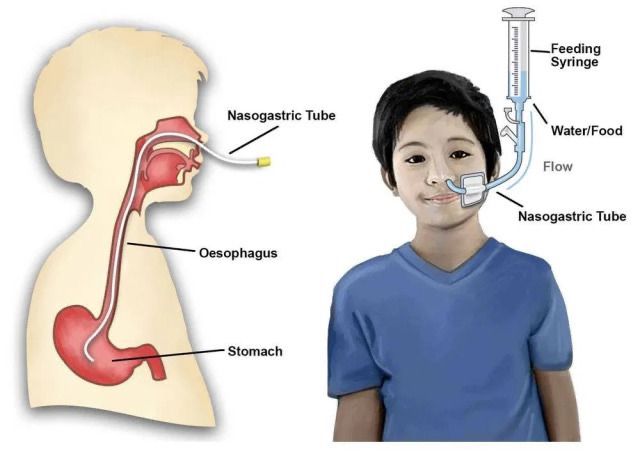Feeding Tubes: What Every Nutritionist Should Know

Feeding tubes are life-saving medical devices used to deliver essential nutrients to patients who cannot eat or swallow normally. As nutritionists, understanding feeding tube types, indications, care, and complications is crucial for ensuring optimal patient outcomes. Whether in hospitals, home care, or long-term facilities, our role is to guide patients, caregivers, and healthcare teams on the best nutritional strategies.
Why Are Feeding Tubes Used?
Feeding tubes are used when a patient has difficulty eating, swallowing, or digesting food but still has a functioning digestive system. The goal is to prevent malnutrition, dehydration, and muscle loss while ensuring the body gets adequate nutrition.
Common Conditions Requiring Feeding Tubes:
✅ Stroke, Parkinson’s disease, ALS (difficulty swallowing)
✅ Severe malnutrition or prolonged illness
✅ Cancer of the throat, oesophagus, or stomach
✅ Head, neck, or gastrointestinal surgeries
✅ Severe burns, trauma, or coma
✅ Gastroparesis or other GI motility disorders
Types of Feeding Tubes & Their Uses
Short-Term Feeding Tubes (Less than 4-6 Weeks)
🔹 Nasogastric Tube (NGT): Inserted through the nose into the stomach. Used for short-term feeding when swallowing is impaired.
🔹 Nasoduodenal (NDT) or Nasojejunal Tube (NJT): Goes through the nose into the small intestine. Used for patients with gastroparesis or severe reflux.
Long-Term Feeding Tubes (More than 4-6 Weeks)
🔹 Gastrostomy Tube (G-tube or PEG tube): Surgically inserted into the stomach. Used for long-term conditions like neurological disorders, head injuries, or chronic diseases.
🔹 Jejunostomy Tube (J-tube): Inserted directly into the small intestine. Used when stomach feeding is not an option due to severe reflux, gastroparesis, or surgeries.
What Should Nutritionists Know?
1️⃣ Assessing Nutritional Needs
🔸 Calories, protein, and hydration must be tailored to each patient based on age, medical condition, and metabolic needs.
🔸 Specialized formulas are available for conditions like diabetes, kidney disease, or malabsorption disorders.
2️⃣ Selecting the Right Feeding Regimen
There are three main types of feeding regimens:
✔ Bolus Feeding: Large amounts given at intervals, similar to mealtime. Best for G-tube patients with normal digestion.
✔ Intermittent Feeding: Smaller, spaced-out meals given via gravity or a pump.
✔ Continuous Feeding: A slow, steady drip via a pump. Best for patients with reflux, aspiration risk, or digestive intolerance.
3️⃣ Preventing & Managing Complications
🔹 Tube Blockages: Flush with water before & after feeding.
🔹 Diarrhea or Constipation: Adjust formula type & fibre content.
🔹 Feeding Intolerance (Bloating, Nausea): Slow down feeding rates or change formulas.
🔹 Aspiration Pneumonia: Keep patients elevated (30-45°) during and after feeding.
4️⃣ Nutritionists’ Role in Patient & Caregiver Education
💡 Teach caregivers how to:
✔ Handle tube feeding safely (sanitization & correct positioning).
✔ Recognize warning signs of infections or intolerance.
✔ Understand when and how to transition from tube feeding to oral feeding if possible.
Case Study: Feeding Tube Nutrition Saves a Patient’s Life
Patient Profile:
Mrs Kemi, a 45-year-old woman with severe throat cancer, underwent radiation therapy and lost the ability to swallow. She lost 10kg in one month and was severely malnourished.
Intervention:
A PEG tube was inserted, and her nutritionist formulated a high-calorie, high-protein enteral feeding plan to prevent further weight loss, support healing, and maintain hydration.
Outcome:
✔ In two weeks, her weight stabilized.
✔ In one month, her energy improved, and her muscle loss reduced.
✔ Over time, speech therapy helped her regain partial swallowing function, and she transitioned to blended oral feeding.
Final Thoughts: The Nutritionist’s Role in Tube Feeding
Nutritionists play a crucial role in ensuring that patients on feeding tubes get the right balance of nutrients, fluids, and medications while preventing complications. Whether you work in hospitals, home care, or wellness centres, understanding tube feeding helps you improve patient outcomes and provide lifesaving care.

